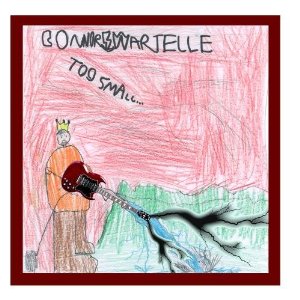Dear Heartwood Beat Readers,
Sometimes I come across a rhythm that’s so complicated, or weird, or fantabulishously funky, that I can’t stand it. I’m at the gym on the hamster wheel, listening to this cool groove on my iPod, and I want to grab the poor guy on the machine next to me and yell, “You gotta hear this!”
 Thankfully, there are other people I can turn to, like the great drummer and teacher Mark DiFlorio (that’s him on the right). Here are Mark’s reactions to some of my favorite Strange and Wonderful Rhythms. I’ve included clips of each of the songs we discuss. They’ll open in a new window/tab so that you can read as you listen.
Thankfully, there are other people I can turn to, like the great drummer and teacher Mark DiFlorio (that’s him on the right). Here are Mark’s reactions to some of my favorite Strange and Wonderful Rhythms. I’ve included clips of each of the songs we discuss. They’ll open in a new window/tab so that you can read as you listen.
Rhythm #1: “Unison” by Bjork, starting at 0:20
(LISTEN)
Rob: I love that electronic instrument that comes in at 0:20—not the bass, but that other thing (who knows what it is, it’s so heavily processed). It sounds a touch out-of-sync with the rest of the song, but I can’t figure out why—I just know I like it. Is it swinging a little, or is the rest of the band swinging and it’s not?
Mark: What I’m hearing that makes it a touch out-of-sync is that the sound is layered in two parts: A percussive clicking, and a tonal flute-like sound. The percussive clicking itself is a flam, like the sound of two hands clapping not quite at the same time. The flammed percussive clicking sound happens ever-so-slightly earlier than the tonal flute-like sound. This gives the sound some length, with the tonal part of the sound happening a little later than the exact subdivision each time. This lateness is what I think makes the part “swing.”
Rhythm #2: “Rockin’ Chair” by The Band, starting at 0:16
(LISTEN)
Rob: As a follow-up, this mandolin part is definitely playing straight while the rest of the band is swinging. I love that opposition! How often do you hear musicians do this?
Mark: I hear this all of the time, especially in jazz, and music that involves improvisation. It’s often done intentionally to create some rhythmic tension, eventually to be released coming out of a solo or into another part, like the chorus. When it’s done throughout different parts of a song or solo, it gives the music a natural ebb and flow.
(Note from Rob: If you like this song, there’s more written about it than you could possibly imagine here.)
Rhythm #3: “Honky Tonk Women” by The Rolling Stones, 0:00-0:50
(LISTEN)
Rob: I don’t mean to pick on one of my favorite guitarists, but in this live performance, Keith Richards’ rhythm is too loose for my tastes. I want to shout at him, “Tap your foot,” or maybe, “Sober up!”
I’ve heard you describe some of your favorite drummers as having “greasy” rhythm because of their loose feel—what makes some musicians greasy and others just sloppy?
Mark: Technically, what makes a musician “greasy” is his ability to manipualte and control the spacing of his rhythms. A greasy rhythm is not subdivided evenly, but is always being varied while remaining within the overall parameters of the tempo.
I usually talk about greasy when referring to New Orleans drummers like Johnny Vidacovich. Johnny’s hi-hat patterns lay back with wide swinging 8th notes, and push forward with tight straight 8ths. His snare drum is sometimes far behind the bass player, while at the same time his ride cymbal is pushing ahead with the pianist.
But what truly makes a musician greasy is attitude. If you walk a straight line in life, you most likely will sound like that. And if you live in New Orleans sweating in the summers, drinking the tap water and eating red beans and rice, then that what you sound like.
Rhythm #4: “Dance of the Sugar Plum Fairy” by Tchaikovsky
(LISTEN)
Rob: Here’s a counterpoint to Keith: A performance on the celesta that’s too pretty to be called “greasy.” Still, it has slight variations in tempo (and dynamics)—little ebbs and flows, like at 0:15—that I find gorgeous. What do you think? Beautiful? Sloppy?
Mark: Beautiful! Not sloppy. It ebbs and flows very naturally. I don’t think anyone is telling this conductor, “Tap your foot,” or “Sober up!” This music serves a different purpose and was created and is performed with a different intention. There is different attitude behind it.
Rhythm #5: “Red House” by Jimi Hendrix, 0:00-0:09
(LISTEN)
Rob: Aw, yeah! I taught this song recently, and hadn’t realized until then how rhythmically cool this intro is. It was a challenge to teach. How would you explain to a beginning musician what’s going on in this section? How would you recommend they count along with it, and learn how to play the rhythm?
Mark: Subdivide! I would have my student listen to this from the perspective of 4/4 and 6/8.
4/4
The intro begins with the guitar clicking on beat 4 of the pick-up measure. The bass notes are struck on beats 1, 2, 3, and 4 of the next two measures and finally on beat 1 of the third measure.
(Listen to Rob doing this)
6/8
The intro begins with the guitar clicking on beat 4 of the 6/8 measure and then continues to subdivide along the 6/8 count.
(Listen to Rob doing this)
The drummer enters on beat 2 of the measure and groups his fill in 2’s (snare drum & bass drum), which makes counting tricky. This goes until the end of the next measure when he strikes his toms on beats 4, 5, and 6, and then starts his groove. Something like this:
1 2 3 4 5 6 | 1 2 3 4 5 6 | 1 2 3 4 5 6
s b s b s | b s b t t t | GROOVE
s = snare
b = bass
t = toms
Rhythm #6: “One” by Metallica, 4:20-End
(LISTEN)
Rob: RAWK! I’m not a big metal fan, but I love this song. Weren’t you into metal in high school? Did you ever learn that fast double-kick-drum technique? The guitar matches the kick-drum rhythm in parts of this song, and it requires some insanely fast picking. I can’t imagine what it’s like to do it with your feet.
Mark: I was, more specifically, a “hair band fan” in high school. (Have I shown you the pictures? I must!) Motley Crue, Ratt, Poison, etc… and although the hair is what inspired me the most I did have a double bass drum pedal at one time. I never learned to use it.
I eventually stopped showering, became a hippy and never quite cultivated the aggressiveness that seems to be needed to acquire burning double bass drum chops. I’ve begun showering again.
Rhythm #7: “Over the Hills and Far Away” by Led Zeppelin, 0:00-1:09
(LISTEN)
Rob: You have no idea how much it grieves me that I can’t tap my foot with one of my favorite songs. What’s wrong with me?
Mark: I have good news for you, Rob. Nothing is wrong with you, and I have an answer that just might have you tapping your foot in a whole new way.
You see, this song has a quarter-note pulse (which is where you want to tap your foot), but is subdivided in alternating phrases of 9/8 and 7/8 (which makes for some weird-feeling foot-tapping). Here’s how the measures are subdived until the drums enter:
(The numbers refer to the number of 8th notes there are in the measure. Keep in mind the song begins with two 8th-note pick-ups, so you don’t start counting immediately.)
9-7-9-7-9-7-8-8-8
9-7-9-7-9-7-8-8-8-8 enter vocals
9-7-9-7-9-7-8-8-8-8-8-8-8-8 enter drums
I have two options for you. Try both:
1) You can tap your foot to the 8th note subdivision, which is twice as fast as you’d naturally approach tapping your foot to this song.
(Listen to Rob counting this way)
OR
2) Since 9 + 7 = 16, you can tap your foot on the quarter note and it will work out in the end. It may sometimes feel awkward as you will be tapping on the upbeats during the measures of 7/8 but rest assured you will be back on the downbeat when the 7 is over.
(Listen to Rob counting this way)
It’s all quarter-note foot tapping after the drums enter, and although there is a 5/4 measure coming out of the guitar solo, the quarter note pulse is still your friend.
Rhythm #8: My Wiper Blades
Rob: I love grooving with rhythms in everyday life—the turn signal, windshield wipers, industrial machinery. Do you do that too?
Mark: I groove to every sound and rhythm that I hear in the world, especially my wiper blades. Wiper blade pulses & tempos vary widely. I’ve had cars with swingin’ wiper blades, very straight and tight pulses and everything in between depending on the weather.
Recently I’ve been jamming to the clicking of the motor on my infant daughter’s swing. Its rhythm is consistenly irregular and I can only jam along with it by guestimating the unevenly subdivided pause before it repeats.
You might say it’s greasy!
*
You can learn more about Mark’s teaching at his Seattle Drum Lessons website.
 The Princess Bride. A ’59 Les Paul. Lucky the goldfish’s funeral.
The Princess Bride. A ’59 Les Paul. Lucky the goldfish’s funeral.





 Thankfully, there are other people I can turn to, like the great drummer and teacher Mark DiFlorio (that’s him on the right). Here are Mark’s reactions to some of my favorite Strange and Wonderful Rhythms. I’ve included clips of each of the songs we discuss. They’ll open in a new window/tab so that you can read as you listen.
Thankfully, there are other people I can turn to, like the great drummer and teacher Mark DiFlorio (that’s him on the right). Here are Mark’s reactions to some of my favorite Strange and Wonderful Rhythms. I’ve included clips of each of the songs we discuss. They’ll open in a new window/tab so that you can read as you listen.